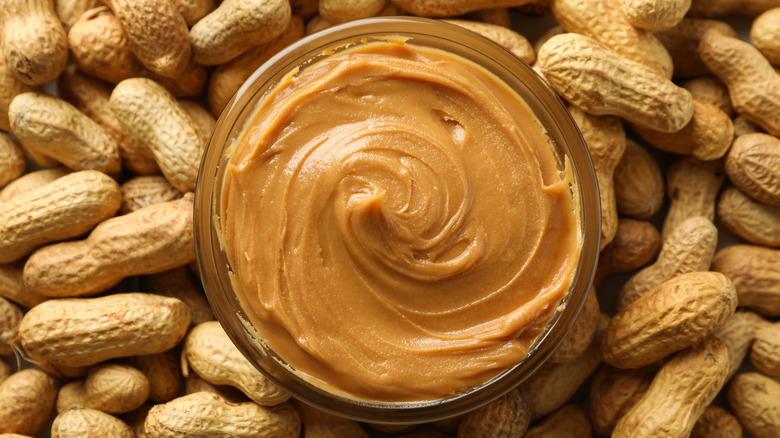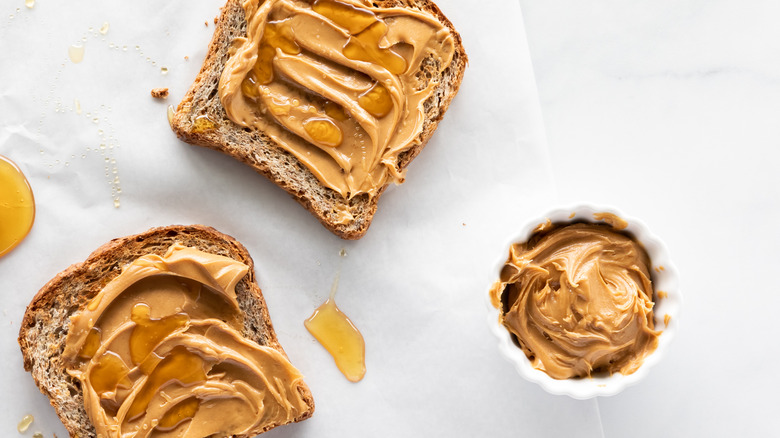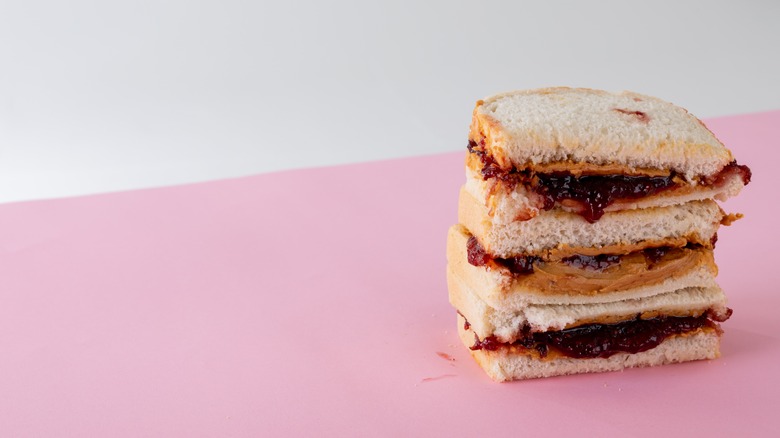The Important Role WW1 Played In Popularizing Peanut Butter
Ah, peanut butter, that magical spread that pairs perfectly with jelly, inhabits the chocolatey innards of a Reese's Peanut Butter Cup, and tastes great spooned straight from the jar. This beloved nutty concoction is an American pantry staple, a go-to companion for toast, and an affordable source of protein. Frankly, it's nearly impossible to imagine life without it.
And few things are more traditionally "American." Statista shares that in 2020, alone, 299.34 million U.S. citizens indulged in peanut butter. The New York Daily News offers that a Peter Pan Peanut Butter survey in 2016 revealed that the average American will devour 2,984 peanut butter and jelly sandwiches over the course of their lifetime. And, interestingly, there are six cities in America that bear the name "Peanut" (via National Peanut Board). Clearly, peanut butter has left an indelible mark on this nation.
There was a time, however, when peanut butter was a novel oddity. It wasn't all that long ago that this common item wasn't considered common at all. What happened to transform it into the popular food it is today?
Peanut butter became a WWI meat replacement
When you think of what was needed to fight World War I, you might think of tanks, planes, ships, and weaponry. One aspect that is often overlooked is food. With many of the allies' able-bodied men on battlefields, farms found themselves without workers. The soldiers greatly needed sustenance, as did those left behind to keep the home fires burning.
The U.S. government did not introduce rations, but they did make citizens keenly aware that they needed to cut back on consuming foods like grains, sugar, and, of course, red meat. Why? Mental Floss explains that the troops needed high-calorie foods to sustain them during battle and that became priority number one. A simple way for the government to foster this shift was to circulate pamphlets that encouraged people to adopt "meatless Mondays," a move that Smithsonian Magazine says led to the humble peanut being touted as a viable plant-based meat alternative.
One must keep in mind that at this time, peanut butter was a relatively rare thing. How, then, did this move towards cooking with peanuts lead to actual peanut butter?
Partially hydrogenated peanut butter was a game-changer
According to the American Historical Association, the peanut and other members of the legume family were introduced in loaves, croquettes, and even soup. Gradually, the best of these recipes began to appear in wartime cookbooks, as a curator at the National WWI Museum and Memorial, Lora Vogt, told Fox News. Vogt adds that among the most popular concoctions were peanut loaf and peanut butter soup.
Meanwhile, manufacturers had taken to selling massive containers of peanut butter to grocery stores, but the constant need for the oil to be stirred back in proved problematic. Smithsonian Magazine says this led to spoilage, prompting Joseph Rosefield to patent his "partial hydrogenation" process in 1921, making constant stirring unnecessary. Finally, the public had spreadable peanut butter that was much closer to today's version.
When a St. Louis baker introduced sliced bread in the late 1920s, the peanut butter sandwich became a common dish, particularly for children. This was an important moment in the history of food. After all, peanut butter fans will agree — the only thing better than sliced bread is sliced bread smothered in peanut butter.


